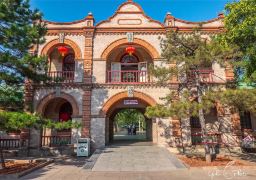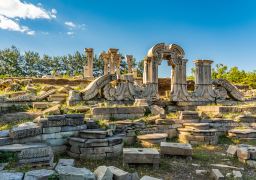Dule Temple is located within the ancient Yuyang Street in Ji County, Tianjin, and was originally constructed during the Sui Dynasty, with reconstructions during the Liao Dynasty. It is one of the three existing Liao Dynasty temples in China, with a history of over 1000 years. The Shanmen (mountain gate), Guanyin Pavilion, and the statues within these two structures are Liao Dynasty relics. Other buildings were constructed after the Ming Dynasty and also house numerous historical artifacts for visitors to explore.
Dule Temple is not large, with its main structures aligned along a central axis, allowing visitors to tour the buildings one by one. During the Tang Dynasty, the area was under the jurisdiction of the Central Plains, but by the Liao Dynasty, it became a remote region. Despite changes in architectural styles in the Central Plains, Dule Temple continued to uphold the Tang Dynasty style, making it quite unique when compared to the predominantly Ming and Qing Dynasty styles of ancient architecture that have been preserved.
One characteristic of Tang Dynasty architecture is the large roof, which is evident in the temple’s Shanmen with its expansive eaves, marking it as one of the earliest wǔdiàn dǐng Shanmen still in existence. The chī wěn dragon tails on the roof turn inward, contrasting with the outward-turned chī wěn dragon tails of Ming and Qing temples, indicating an earlier period of architecture. The plaque with the words ‘Dule Temple’ above the gate is said to be written by the Ming Dynasty official Yan Song. Inside the Shanmen, the Liao Dynasty’s colorful sculptures of the ‘Heng and Ha generals’ and the Qing Dynasty’s murals are exquisite.
Beyond the Shanmen lies the main structure of Dule Temple, the Guanyin Pavilion, a wooden construction without a single nail, making it one of the earliest wooden structures in China. Visitors can observe the interlocking mortise and tenon joints under the eaves. The plaque ‘Guanyin’s Pavilion’ above the door is believed to be written by the Tang Dynasty poet Li Bai. The pavilion appears to be two stories from the outside but actually has three levels, with a hidden layer between the upper and lower levels. Inside the Guanyin Pavilion is the ‘treasure of the temple’—a large colored clay statue of Guanyin, standing at 16.27 meters tall, with its head passing through three stories to the top, and an additional ten small heads on top, known as the ‘Eleven-faced Guanyin’. Unfortunately, due to cultural preservation, visitors can no longer climb the upper levels of the Guanyin Pavilion and can only admire the statue from the first floor.
Also worth noting are the ancient Bodhisattva statues on either side of the Guanyin statue, which continue the style of Tang Dynasty female paintings, and the exquisite Ming Dynasty murals on the walls. Behind the Guanyin Pavilion is the octagonal Weta Pavilion. Behind the Weta Pavilion lies the Bao’en Courtyard. In the front hall of the Bao’en Courtyard, the Maitreya Hall, the statues of Maitreya and the four ‘crazy monks’—Han Shan, Pu Hua, Feng Bo, and Ji Gong—are placed together, making Dule Temple’s layout and the veneration of Bodhisattvas quite rare. The rear hall of the Bao’en Courtyard is the Three Buddhas Hall, with the Wen Shu Hall and the Pu Xian Hall as the eastern and western side halls, respectively. Off the central axis of Dule Temple, on the east side, is the Qianlong Palace, once a resting place for Qing Dynasty emperors on their way to the Eastern Tombs, now housing 28 steles inscribed with Qianlong’s calligraphy.
Another attraction is the exhibition hall located to the northwest, showcasing ancient artifacts from Ji County, allowing visitors to gain a deeper understanding of the history of Ji County and Dule Temple. South of Dule Temple stands the White Pagoda Temple, with its distinctive white pagoda situated right at the focal point of the gaze of Dule Temple’s Guanyin statue. The pagoda’s unique design is a blend of Chinese and Indian architectural styles. The temple is only 300 meters away from Dule Temple and is worth a stroll to visit. Dule Temple hosts Dharma assemblies on the birthdays and commemorative days of various Bodhisattvas. Every Spring Festival, with Dule Temple at the center, several neighboring streets hold a temple fair, featuring lion dances, stilt-walking, acrobatics, and numerous handicraft and snack stalls selling kites, windmills, clay figurines, paper-cuttings, candied hawthorn, and donkey rolls, making it a very lively event. The entire site is open year-round from 08:00 to 17:00. Preferential policies include: Children: Free for children under 6 years old or under 1.2 meters in height; half price for minors aged 6 to 18 years old. Students: Half price for full-time undergraduate students and below with a valid student ID. Elderly: Free for elderly aged 70 and above with a valid elderly ID or ID card; half price for elderly aged 60 to 69 with a valid elderly ID or ID card. Military personnel: Free for active-duty soldiers, firefighters, retired military personnel, disabled veterans, and those receiving regular state pensions or subsidies with valid identification. Disabled: Free for those holding a ‘People’s Republic of China Disabled Person’s Certificate’. Hong Kong, Macao, and Taiwan tourists: Half price for young visitors with a valid ‘Hong Kong and Macao Residents Traveling to Mainland Permit’, ‘Taiwan Residents Traveling to Mainland Permit’, or student ID. Additional information: Preferential tickets must be purchased at the scenic area’s ticket office.









